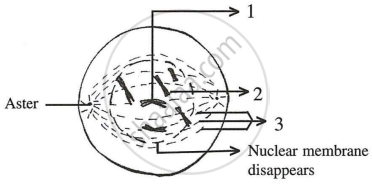Advertisements
Advertisements
Question
Multiple Choice Question:
Karyokinesis is the division of
Options
Cytoplasm
Nucleus
Cell wall
Pollen grains
Solution
Nucleus
APPEARS IN
RELATED QUESTIONS
The diagram given below represents a stage during cell division.
Study the same and answer the questions that follow:

- Identify whether it is a plant cell or an animal cell. Give a reason in support of your answer.
- Name the stage depicted in the diagram. What is the unique feature observed in this stage?
- Name the type of cell division that occurs during:
- Replacement of old leaves by new ones
- Formation of gametes
- What is the stage that comes before the stage shown in the diagram?
- Draw a neat, labelled diagram of the stage mentioned in (iv) above keeping the chromosome number constant.
Given below is a diagram representing a stage during mitotic cell division in an animal cell Examine it carefully and answer the questions which follow.

- Identify the stage. Give one reason in support of your answer.
- Name the cell organelle that forms the ‘aster’.
- Name the parts labelled 1, 2 and 3.
- Name the stage that follows the one shown above; how is that stage identified?
- Mention two differences between mitosis and meiosis with regards to:
- The number of daughter cells produced.
- The chromosome number in the daughter cells.
Fill in the blank:
______ takes place in body cells resulting in growth and development.
Fill in the blank:
______ is the indirect cell division.
Differentiate between Centrosome and centromere.
Explain the Term Pachytene
Name the following:
The kind of division normally seen at the tip of the root and shoot system.
Name the Following
Nuclear envelope and nucleoli reappear in which stage.
Mention, if the following statement is True or False. If false rewrite the wrong statement in its correct form:
The alkaloid colchicine inhibits the formation of the mitotic spindle.
